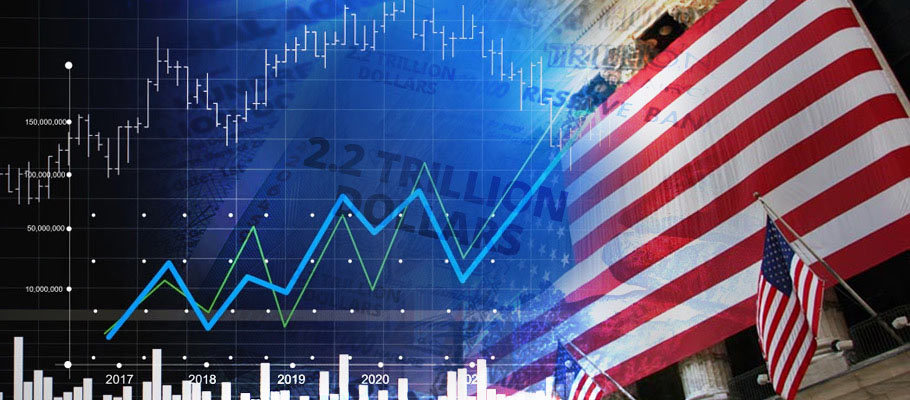
Published: March 31st, 2020
The battle to save the global economy from the ravaging effects of the coronavirus pandemic continues. On Thursday, March 26, the Trump administration and the U.S. Senate agreed on a relief bill worth $2 trillion. The administration’s response was enough to stimulate the stock market, which saw several equities record session highs.
Most U.S. stock indexes made the most of the huge $2 trillion coronavirus stimulus package to record gains on Thursday, March 26, day’s trading session. Earlier on, the U.S. Senate ended a protracted debate to agree with the Trump administration on an enormous relief bill that is supposed to rescue the American public from the effects of the coronavirus pandemic.
The Dow Jones Industrial Average gained some 1,300 points, the equivalent of 6% during the session. The index was, however, unable to hold on to the gains by the day’s closing, posting 21,200 points, which is +495 points or 2.4%.
Another index that was on an upward trajectory, The S&P 500, closed the day with 28 more points to stand at 2,475, a gain of 1.2%. Nasdaq 100, however, was not as lucky. It shed a portion of the gains it raked in during the previous session to close the day 84 points lighter. The slump translates to -1.1% loss, which left the index standing at 7,469 points.
These passably impressive numbers came in despite the Department of Labor’s current record high unemployment figures. Seemingly, investors turned a blind eye to the employment stats and instead chose to focus on the prospects of a $2 trillion relief bill as well as any other such packages that may be on the way.
The U.S. Congress later on Friday passed the bill which is intended to provide the economy with enough cash to help America curtail the mangling effects of the coronavirus pandemic. Already, the world’s largest economy is crumbling with some 3.3 million Americans filing for unemployment benefits in the past week alone. These figures by far outstrip the previous record of 695,000 filed back in 1982.
Christopher Dembik who heads the macroeconomics analysis department at Saxo Bank thinks that these figures are distressing. He wrote that the country has transitioned from full employment to job destruction whose numbers have not been witnessed during a period of peace. Dembik stressed that the economy needs to steady fast.
The stats are mixed now but no one can tell with certainty for how long the markets will be receptive.
Despite the trillions of dollars pouring into the economy, even the U.S. Federal Reserve Chair Jerome Powell is pessimistic. On Thursday, he said that the U.S. economy is steadily slipping recession if it is not already there.
He added that the reopening of the economy, which the Trump administration is pushing for, should depend entirely on the status and spread of the coronavirus pandemic. His statement contradicts the President’s stand. The U.S. leader prefers an earlier opening that will have the economy up and running by Easter.
This ambition may be unattainable considering that the number of confirmed cases of coronavirus in the U.S. have dashed passed the 100,000th mark with some 1,600 confirmed deaths by Sunday, March 29.
As the U.S. stocks attained session highs, the situation was replicated in most economic blocks across the globe. Shares in Asia rallied following the news of the U.S. stimulus package. Japan’s Nikkei gained 8%, the index’s two-week high. Chinese blue chips were also up 2.82% while MSCI's Asia Pacific Index surged almost 10%. In Australia, the S&P/ASX 500 climbed 5.54% as the Korea Stock Exchange KOSPI gained 5.71%.
The story was the same in Europe. The London FTSE, France’s CAC, and German’s DAX all rose to push Europe’s STOXX 600 up by 2.9%.
These gains were inspired by the Dow Jones Industrial Average’s surge of 11.37% on Tuesday, the biggest climb since 1933.
Experts warn, however, that these impressive climbs may not be sustained even in the short-term. They cite the locked shops, as well as the travel lockdowns which they believe, may distort economic growth. Stephen Innes who is AxiCorp’s strategist for the Asia Pacific market said that the stimulus package has the potential to rescue both businesses and consumers for the next few months. He, however, was not certain how long the relief package’s rescue mission may last.
Innes added that he sees the markets getting by this week as well, probably because of the stimulus. He, however, wonders what will happen next, especially, if the cases of Corvid-19 increase in the U.S. The economist reasons that the government will not keep printing more money if the people that are supposed to spend it are on lockdown. For this reason, Innes does not think the market is capable of sustaining the rally.
These sentiments are echoed by the head economist and lead researcher for the Asia Pacific market at ING, Robert Carnell. He admits that it is great that the Trump administration is directing something to the economy. Carnell, however, points out that whatever injection is going into the economy now will not adequately reverse the beating that the coronavirus pandemic has meted on it.
He says that healthcare should be the chief beneficiary of the stimulus followed closely by employees and small businesses since they have suffered the most due to the lockdowns.
Danny Wong, CEO of Areca Capital in Kuala Lumpur weighs in saying that any more stock rallies will only depend on how long the movement and travel restrictions stay in place.
The stimulus package that the U.S. Senate and the Trump administration agreed on seemed to have wowed the markets. The news of so much money coming into the economy excited investors and sent the price of stocks gaining. The Dow Jones stunned the markets as a result, and its impressive performance was replicated all over, from Asia and Australia to Europe. Sustaining the good performance, however, is a different ballgame altogether.